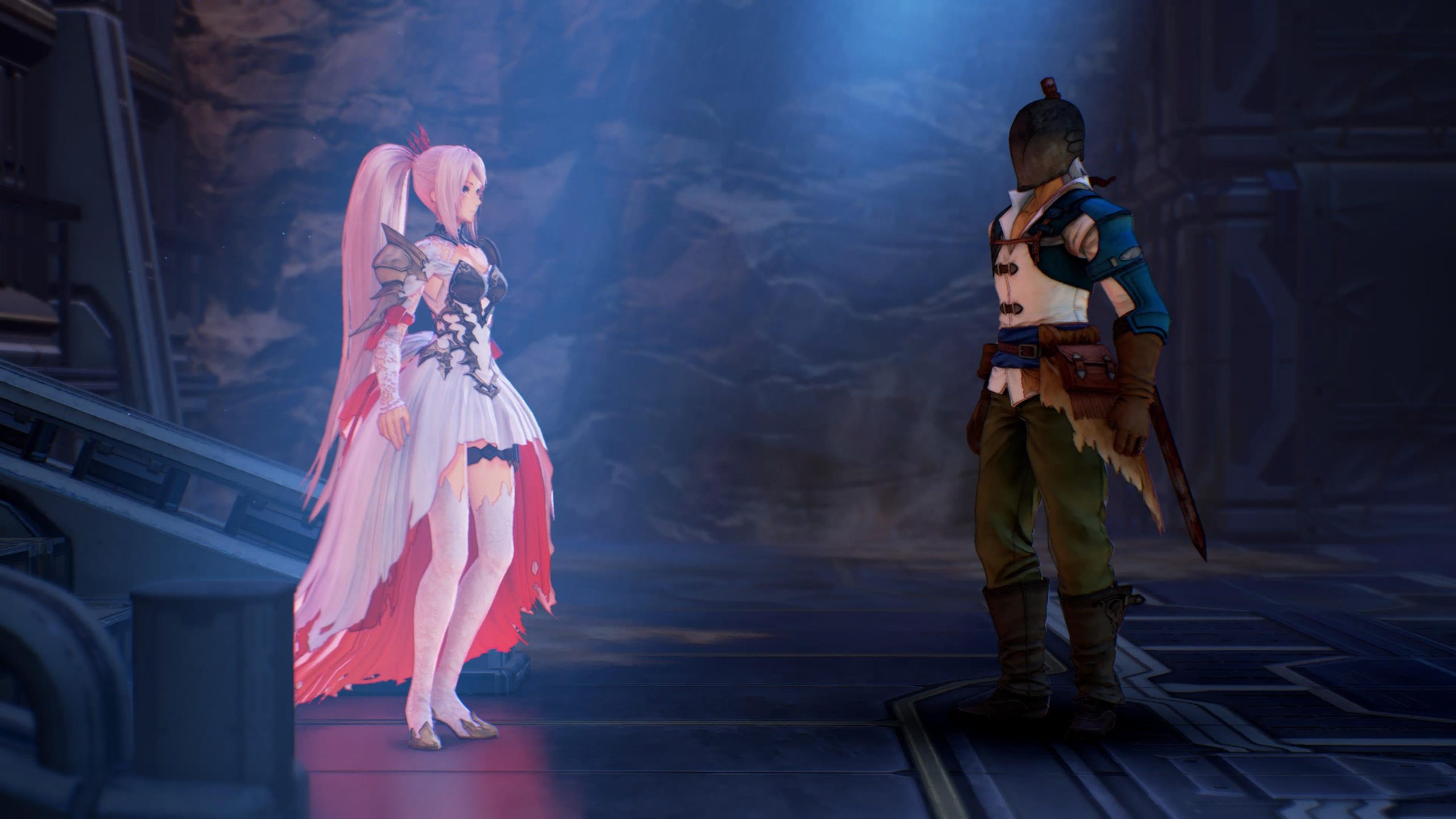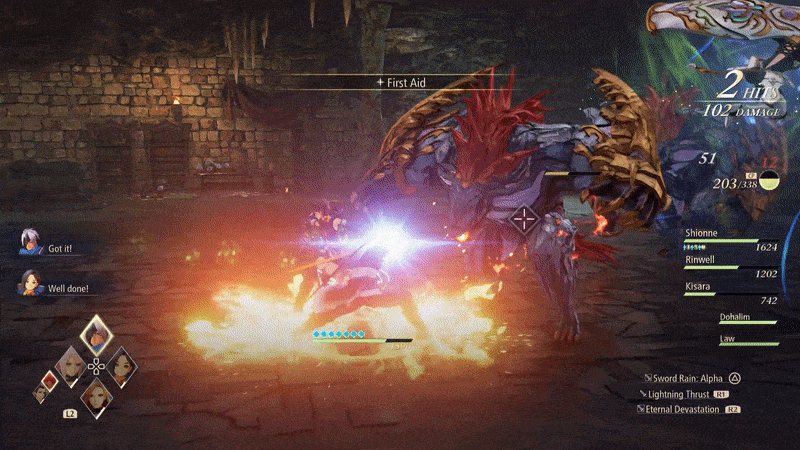Dozens of hours into Tales of Arise, a new role-playing game from Bandai Namco, one of your party members asks, “Is it over?”
It’s a fair question. By then, you’ve fully traversed the game’s world. You’ve collected the requisite five MacGuffins. And at long last, you take down the big bad — defeating him not just once but, in keeping with the Final Boss Accords, overcoming his secondary, magnitudes-more-powerful form, too. That double-header is followed by a thrilling, exquisitely choreographed cutscene and a few mind-boggling plot twists that seem primed to set up a sequel. Pretty much everything about the sequence indicates that, if Tales of Arise isn’t over yet, it’s definitely about to be, right?
“No,” another party member responds. “It’s only just begun.”
And then you see this screen:
I LOL’d. I also wept.
Yes, Tales of Arise is full of such bang-your-head-on-the-desk moments, but there’s also a whole lot to like. For one, it’s jaw-droppingly gorgeous, particularly compared to previous entries, a natural result of Bandai Namco pivoting development to the Unreal Engine. That development shift has also led to an overhaul of the combat system, which upends the longstanding formula so dramatically and positively that I genuinely cannot imagine going back to older Tales games now.
Its plot is saccharine and reductive, but it’s also a deliciously cascading mystery, one that answers each question by raising two more that are far more intriguing than the first. And of course, there’s the cast of six characters — the main reason people play these games in the first place — which is, dare I say, the strongest it’s ever been. (Apologies to Lloyd and co.) Arise’s characters grow and bond in ways that are genuinely moving, at times even tear-jerking. In those moments, the game is a delight.
But I also found myself regularly peeved by its litany of minor irritants: by the cutscenes that drone on for too long, by the dialogue you can’t skip, by the boss fights that are nothing more than HP-sponge tedium, by the late-game enemies that aren’t mechanically different from the early-game enemies, by the fetch quests you have to complete because you’d be underleveled otherwise, by the dungeons you have to retread in reverse, by the attacks you spam literal hundreds of times (always accompanied by a character shouting the same incantation). Most of all, I bristled at a story that tackles heavy topics but doesn’t always handle them with the necessary care.
I am, in other words, of two minds here. I suppose that’s fitting. After all, Tales of Arise is explicitly a game of dualities.
Years ago, former Kotaku news editor Jason Schreier likened Tales games to fast food. Though a Tales game will never blow your mind, he said, you at least know what you’re getting. And if that’s what you’re in the mood for, man, it hits the spot. Tales of Arise continues in that vein, kind of. Think of it like this: If Tales of Symphonia, Vesperia, and Berseria are the McD’s, BK, and Wendy’s of JRPGs, Tales of Arise is more like the Sweetgreen — it’s still fast food, you still know exactly what you’re paying for, but it’s arguably a bit more nutritious.
Tales of Arise, the 516th or 517th (who’s counting?) mainline entry in Bandai Namco’s series of action RPGs, officially came out last week for PC, Xbox, and PlayStation, where I’ve been playing. Like most Tales games, it’s a standalone entry; you don’t need to play prior entries or trudge through a byzantine network of wiki pages to grasp this one.
Good news, too, because the premise is already a word salad of proper nouns. Tales of Arise is about the rift between two neighbouring planets, Dahna and Rena. Three centuries before the game’s events, Rena, a space-faring nation clearly at the tail end of Civ 6’s technology tree, invades Dahna. Rena wins the war handily, and wholly subjugates Dahna, enslaving its entire populace.
The Renans embed so-called “cores” into the hands of every Dahnan, which collect astral energy — a fictional life force that’s supposedly existent in all living things — from whomever they’re embedded in. Rena installs heads of state, called lords, over Dahna’s five regions. Whichever lord is able to accrue the most astral energy over a seven-year period wins what’s known as the “crown contest” and becomes the supreme leader of Rena for the next seven years.
[review heading=”Tales of Arise” image=”https://www.gizmodo.com.au/wp-content/uploads/sites/3/2021/09/16/94478a22e076d9d9b5cb3eb312162fb6.jpg” label1=”Back of the box quote” description1=”‘I fight for my friends.’ — Every character, every five minutes” label2=”Type of Game” description2=”Never-ending test of patience” label3=”Liked” description3=”Thrilling combat, riveting characters” label4=”Disliked” description4=”Between the tedium, there’s some seriously eyebrow-raising messaging” label5=”Developer” description5=”Bandai Namco” label6=”Platforms” description6=”PS4, PS5 (played), Xbox One, Xbox Series X/S, PC” label7=”Played” description7=”41 hours and 21 minutes, roughly nine hours of which was spent in combat, to complete 40 side-quests and get to the final string on critical path dungeons. I’ll beat it soon. I think.” ]
The game focuses on two primary protagonists: Shionne, a woman with a mysterious past, and Iron Mask, a man who has no memory and also wears an iron mask that he can’t remove, thus preventing him from recalling his name or even what his face looks like. I’m just gonna blow the first spoiler because it goes on for too long and also because Bandai Namco itself revealed the info in screenshots, trailers, blog posts, promotional art, summer previews, and on the game’s splash screen. Iron Mask is really named Alphen. He has spiky hair and calls people “bastards” a lot. Y’know: a Tales protagonist.
Shionne and Alphen are locked in eternal ebb and flow. She’s from Rena. He’s from Dahna. She’s aloof and resigned. He’s open and idealistic. She hurts anyone who comes within an inch of her, thanks to an abstruse bodily reaction. He can’t feel pain. She has within her a magical fire sword that only he can wield. You can almost hear the CBS sitcom narrator.

In short order, Shionne and Alphen pick up four party members. There’s Law, a hot-headed martial artist; Rinwell, a young mage who travels with a pet owl named Hootle, who she’d die for; Kisara, a soldier struggling to learn how to think for herself, without orders; and Dohalim, a high-ranking member of the Renan hierarchy who serves as the party’s preeminent intellectual. Their stated goal is simple: Hit up every realm in Dahna, take out all of the lords, liberate the planet, live happily ever after in peace and harmony.
The mission falls into a familiar rhythm. First, you make your way into a new region. You gasp at the view. You work your way through a wide-open area, fighting monsters and collecting items before making your way to that region’s capital. You meet the city’s Dahnan resistance force, a ragtag organisation with a name like “the Silver Swords” or “the Gold Dust Cats.” They need help with some high-stakes mission, which you obviously agree to because you’re a group of heroes. That quest eventually sends you to one big dungeon with a bunch of broken elevators that you have to un-break, which will lead you to the region’s lord, whom you take down in one big boss battle.
Along the way, you go through a progressively more challenging series of dungeons. Most are little more than minimally branching hallways designed to usher you from one fight to the next. Thankfully, combat in Tales of Arise never stops being a blast.
Every battle in Tales of Arise plays out in a circular arena that you can navigate freely. You can jump, you can perform basic attacks, you can dash. You can further assign up to three Artes, or special attacks. These moves, unlike some previous games in the series, are dictated by an “action gauge,” which restores automatically — and within seconds, at that. By landing a bunch of Artes in a row, you slowly fill up an enemy’s stagger gauge. Once that’s full, you can tap a button to coordinate what’s called a “boost strike” between two party members, a splashy move that takes out most rank-and-file enemies in one hit.
So instead of saving your coolest attacks for sticky situations, you’re encouraged to spam the heck out of them. It rules. (One drawback: This is one of those games wherein all party members scream their attacks. As of this writing, I’ve heard Alphen shout “Eternal devastation!!!!”, per the game’s tally, nearly a thousand times.) Later on, you unlock various types of overlimit moves, some of which have special effects, all of which deal devastating damage.
Once you get the hang of it, you can wrap up most fights in seconds. And once you really get the hang of it, you can perform combos that are so frenetic you have a hard time telling what’s going on:

Healing, meanwhile, requires a bit more consideration. Your party shares a pool of cure points. Buffs and healing spells whittle that pool down. It doesn’t automatically recharge. You can supplant your pool of cure points with an item called an orange gel, but those are vanishingly rare (a fact that may make series fans chuckle). All in all, it’s a neat system that contributes to a camaraderie and shared set of stakes among your team. Your character’s health may be just fine. But if your cure points are low, well, you’re all in trouble.
Another fun wrinkle: You can swap between any party members at any point. So if you’re tired of Alphen’s sword-based moveset and want to punch monsters with Law’s fists or shoot them with Shionne’s rifle, you can shake things up with the push of a couple buttons. I’ve largely played as Alphen, since I prefer his frenetic, blade-based toolkit. It’s not Tales if you’re not overusing Demon Fang and Sonic Thrust.
That’s not to say Tales of Arise is absent any battle tedium, though, despite the neat systems. Early dungeons have built-in routes that send you right back to the entrance. Late-game dungeons do not, so you’re forced to backtrack to the start. Oh, and all of the enemies respawn. And since you’re usually exhausted from the dungeon’s boss, every such endeavour feels like an exercise in drudgery simply for the sake of drudgery.
And then there are the side-quests, most of which fall into the broad categories of “finding things” or “killing things.” Side-quests are pretty much the only way to get significant sums of Gald, the game’s currency. Completing side-quests is also the most efficient way to earn skill points, so you’ll have to knock some out if you want to keep your team stocked and leveled enough.
Before You Start: Tips For Playing Tales Of Arise
The best side-quests ditch the cookie-cutter stuff for quiet moments of character development. The worst, in my mind, are battles against so-called “gigants.” A gigantic (get it?) monster is terrorizing a dungeon you’ve cleared. You have to backtrack and kill it. Without fail, such fights last forever and are largely devoid of any sharp strategy, short of pinpointing and hewing to elemental weaknesses. Basically, you smack the big thing until it dies. Zzzz. But you get more money and skill points from these quests than from anything else, and you permanently increase your reserve of cure points with each one, so there’s incentive to roll up your sleeves and tackle the ennui.

A handful of quality-of-life changes and features at least mitigate some of the grind. There’s no world map. There are no random encounters. You can fast-travel most of the time, short of a few story moments that preclude you from doing so (including one lengthy stretch at the halfway point). You need only ever fuss over two pieces of gear per party member — a weapon and a suit of armour, plus an optional accessory. Sleeping at an inn, fully healing your party, is totally free. These streamlined systems help you get to the good stuff: the combat, the bonds between your party members, the central mystery that oozes intrigue and goes to some truly bonkers places.
But as bonkers gets bonkers-er, the plot sputters and falters out of control. At times, it even steps in it. A significant portion of the game’s final act is spent mulling some eyebrow-raising ideals, including narrative beats that suggest oppressors are on the same footing as the oppressed. At one point, following some startling revelations about Renan society, Alphen literally says, “This whole time we’ve been fighting to free Dahna from the Renans. But […] it seems those same Renans might have it just as bad.” (Fact check: They do not.) I haven’t rolled the credits yet, but it’s difficult to picture what sort of 11th-hour twist Tales of Arise could throw to justify narrative beats that effectively both-sides slavery. As more and more players hit the endgame in the coming weeks, I imagine there will be a lot of discussion around its messaging.
Playing a game of this size and scale requires a commitment, one you hope is a two-way street. The selling point of Tales games — which notoriously feature sprawling, lengthy campaigns — has always been that you hand over your precious time in exchange for knowing exactly what you’re gonna get. Tales of Arise doesn’t fully honour that. Some of the changes, from the combat to the streamlined systems, are absolutely welcome. And there’s no shortage of the meat that defines a Tales game, the reason people have flocked to these games for decades: character-driven bonds that are genuinely complex and meaningful, sweeping proclamations about the unassailable power of love and friendship, constant jokes about the entire party being hungrier than Booker DeWitt. But at the same time, there’s no doubt some stuff in here that could blindside you near the end. When you sink this much time into a game, you’d hope the off-putting moments come early, so you can at least know to bounce off.
At the end of the day, if you’re simply seeking a solid if slightly overlong action-RPG about flawed people looking to sand down their rough edges, Tales of Arise is exactly that. Just know that it comes with some rough edges of its own.

Leave a Reply